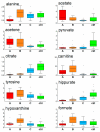Changes in the Urine Metabolomic Profile in Patients Recovering from Severe COVID-19
- PMID: 36984804
- PMCID: PMC10058594
- DOI: 10.3390/metabo13030364
Changes in the Urine Metabolomic Profile in Patients Recovering from Severe COVID-19
Abstract
Metabolomics is a relatively new research area that focuses mostly on the profiling of selected molecules and metabolites within the organism. A SARS-CoV-2 infection itself can lead to major disturbances in the metabolite profile of the infected individuals. The aim of this study was to analyze metabolomic changes in the urine of patients during the acute phase of COVID-19 and approximately one month after infection in the recovery period. We discuss the observed changes in relation to the alterations resulting from changes in the blood plasma metabolome, as described in our previous study. The metabolome analysis was performed using NMR spectroscopy from the urine of patients and controls. The urine samples were collected at three timepoints, namely upon hospital admission, during hospitalization, and after discharge from the hospital. The acute COVID-19 phase induced massive alterations in the metabolic composition of urine was linked with various changes taking place in the organism. Discriminatory analyses showed the feasibility of successful discrimination of COVID-19 patients from healthy controls based on urinary metabolite levels, with the highest significance assigned to citrate, Hippurate, and pyruvate. Our results show that the metabolomic changes persist one month after the acute phase and that the organism is not fully recovered.
Keywords: COVID-19; NMR; discrimination; ketosis; metabolomics; random forest; urine.
Conflict of interest statement
The authors declare no conflict of interest.
Figures




Similar articles
-
Persistence of Metabolomic Changes in Patients during Post-COVID Phase: A Prospective, Observational Study.Metabolites. 2022 Jul 13;12(7):641. doi: 10.3390/metabo12070641. Metabolites. 2022. PMID: 35888766 Free PMC article.
-
A metabolic readout of the urine metabolome of COVID-19 patients.Metabolomics. 2023 Jan 24;19(2):7. doi: 10.1007/s11306-023-01971-6. Metabolomics. 2023. PMID: 36694097 Free PMC article.
-
Urine metabolomics links dysregulation of the tryptophan-kynurenine pathway to inflammation and severity of COVID-19.Sci Rep. 2022 Jun 15;12(1):9959. doi: 10.1038/s41598-022-14292-w. Sci Rep. 2022. PMID: 35705608 Free PMC article.
-
Amino Acid Metabolism is Significantly Altered at the Time of Admission in Hospital for Severe COVID-19 Patients: Findings from Longitudinal Targeted Metabolomics Analysis.Microbiol Spectr. 2021 Dec 22;9(3):e0033821. doi: 10.1128/spectrum.00338-21. Epub 2021 Dec 8. Microbiol Spectr. 2021. PMID: 34878333 Free PMC article.
-
Metabolomic profiling of blood plasma in patients with primary brain tumours: Basal plasma metabolites correlated with tumour grade and plasma biomarker analysis predicts feasibility of the successful statistical discrimination from healthy subjects - a preliminary study.IUBMB Life. 2019 Dec;71(12):1994-2002. doi: 10.1002/iub.2149. Epub 2019 Aug 16. IUBMB Life. 2019. PMID: 31419008
Cited by
-
COVIDomics: Metabolomic Views on COVID-19.Metabolites. 2024 Dec 12;14(12):702. doi: 10.3390/metabo14120702. Metabolites. 2024. PMID: 39728483 Free PMC article.
-
Urine amino acid and gamma aminobutyric acid level in COVID 19 patients.Iran J Microbiol. 2025 Feb;17(1):122-127. doi: 10.18502/ijm.v17i1.17809. Iran J Microbiol. 2025. PMID: 40330059 Free PMC article.
-
Integrated NMR and MS Analysis of the Plasma Metabolome Reveals Major Changes in One-Carbon, Lipid, and Amino Acid Metabolism in Severe and Fatal Cases of COVID-19.Metabolites. 2023 Jul 24;13(7):879. doi: 10.3390/metabo13070879. Metabolites. 2023. PMID: 37512587 Free PMC article.
-
Diagnosis, Severity, and Prognosis from Potential Biomarkers of COVID-19 in Urine: A Review of Clinical and Omics Results.Metabolites. 2024 Dec 22;14(12):724. doi: 10.3390/metabo14120724. Metabolites. 2024. PMID: 39728505 Free PMC article. Review.
-
Metabolomic profiling of COVID-19 using serum and urine samples in intensive care and medical ward cohorts.Sci Rep. 2024 Oct 10;14(1):23713. doi: 10.1038/s41598-024-74641-9. Sci Rep. 2024. PMID: 39390047 Free PMC article.
References
-
- Liptak P., Duricek M., Rosolanka R., Ziacikova I., Kocan I., Uhrik P., Grendar M., Hrnciarova M., Bucova P., Galo D., et al. Gastrointestinal sequalae months after severe acute respiratory syndrome corona virus 2 infection: A prospective, observational study. Eur. J. Gastroenterol. Hepatol. 2022;34:925–932. doi: 10.1097/MEG.0000000000002425. - DOI - PubMed
Grants and funding
- ITMS: 313011AUA4/Integrated Infrastructure Operational Program for the project: New possibilities for laboratory diagnostics and massive screening of SARS-CoV-2 and identification of mechanisms of virus behaviour in human body
- ITMS: 313011ASX4/Integrated Infrastructure Operational Program for the project: Research and development of a telemedicine system to support the monitoring of a possible spread of COVID-19 in order to develop analytical tools used to reduce the risk of infection
LinkOut - more resources
Full Text Sources
Miscellaneous

